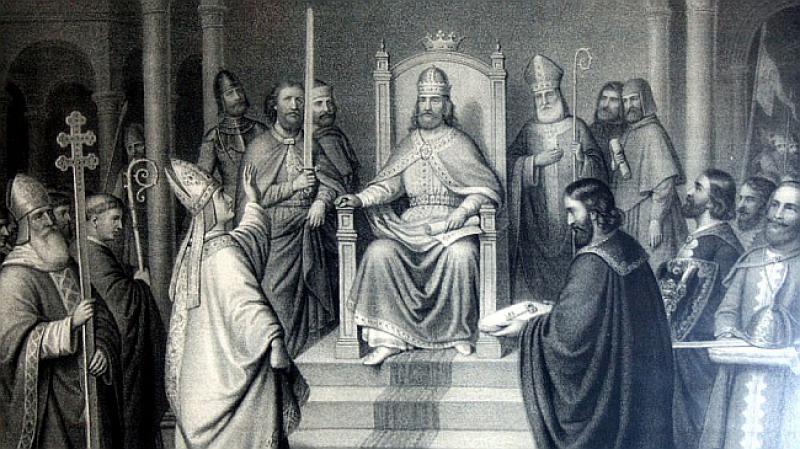Petar Krešimir IV comes to power around 1055. This time, among other things, was marked by the great ecclesiastical schism of 1054 and the further rapprochement of Croatia with the Pope in Rome. Also, Byzantium, which was at war in Asia with the Seljuk Turks and with the Normans in the West, ceded to king Petar Krešimir IV Dalmatian towns and islands. Petar Krešimir I. then he did not take the title of imperial proconsul or eparch, and thus with this cunning diplomatic move he realized the century-old dream of Croatian rulers, to unite Dalmatian towns and islands with the Croatian state. Since then, “regnum Dalmatiae et Chroatiae” was not just a formal title, but meant a single political-administrative territory.

Petar Krešimir IV he was the eldest son of King Stjepan I. He also had a younger brother Gojslav. It was the rule then that power was divided among the brothers, but as Petar Krešimir IV he wanted all the power for himself, he had his brother killed. We learn this from the „Korčula Codex“, which states that Pope Nicholas II sent Cardinal Maynard to investigate the involvement of Petar Krešimir IV with the murder of Gojslav. Allegedly the king and his prefects had to swear that they had nothing to do with the murder after which the case was closed and they acquitted. This is also evidenced by the increased involvement of the papacy in the political affairs of the kingdom.

Order and confirmation of King Petar Krešimir IV
on the territory of the Diocese of Rab (July 8, 1071 in Biograd)
In order to tie the Dalmatian cities more firmly to his state, King Krešimir IV he left independence to the city administrations and undertook by separate documents that he would respect their freedom and old rights as he had found them before. He agreed to some other obligations, such as: confirmation according to the canonical regulations of the elected bishop, free trial and trade. The cities, on the other hand, pledged to King Petar Krešimir IV that they would give him one-third of the port’s revenue, a “tribute of peace,” and that they would help him with their fleet if war broke out.

Petar Krešimir IV he was a great benefactor of the cities and church. Although he collected taxes from big Dalmatian cities, he also encouraged trade and the progress of smaller towns like: Biograd, Skradin, Šibenik and Nin. He donated lands to the church and built monasteries, which can be seen from the preserved church documents from that time.

In the grant of Petar Krešimir IV from 1069, where he donated the island of Maun to the monastery of St. Krševan in Zadar he mentions that his borders were “extended by the almighty God on land and sea” (lat. “quia Deus omnipotenus terra marique nostrum prolungavit regnum”). He also indicated that it was “our own island lying on our Dalmatian sea” (lat. “nostram propriam insulam in nostro Dalmatico mari sitam, que vocatur Mauni”). Probably in his time, the Croatian kingdom included the whole of Dalmatia and Bosnia, and probably Pagania, Travunija and Zahumlje.

Sometime before 1070, Margrave Ulrich II of the Rhine broke into Istria and occupied all border areas of Northern Croatia. Seeing that he is in a difficult position Petar Krešimir IV called for the help of his cousin and ban of Sclavonia (Pannonian Croatia) Dmitar Zvonimir who defeated Ulrik II and has since ruled the area independently. From 1070, Dmitar Zvonimir became the co-ruler of Petar Krešimir IV, and later the heir to the throne.
After the heavy defeat of the Byzantine army in 1071 near Manzikert by the Seljuk Turks, the Byzantine Empire became militarily, economically and politically weak, and the Turks invaded Asia Minor. The Slavs in the north tried to take advantage of this with an uprising, but by 1073 it was suppressed.

Almost from the very arrival of the Normans in southern Italy (at the end of the 10th century), their incursions into Croatian territories began, and during the 11th century there were more and more of them. In 1074, the Norman count of Apuglia, Amico II with the support of Byzantium, he invaded Croatia and attacked cities on the Croatian coast. In a document of the Roman papal legate Gerard from November 1074, it is mentioned that on one such occasion Petar Krešimir IV was captured and died soon afterwards.




You leave out one very important detail, that your writing and understanding of English is exceptional.
Allow yourself a bow.
LikeLike
Thank you very much, my friend…
LikeLike
This was great tto read
LikeLike
Thank you! 👍👍👍
LikeLike